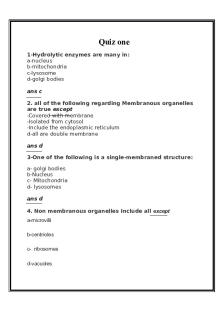I&I - Harland - B cell life PDF

| Title | I&I - Harland - B cell life |
|---|---|
| Author | Oonagh Griffiths |
| Course | Infection and Immunity |
| Institution | Liverpool John Moores University |
| Pages | 2 |
| File Size | 131 KB |
| File Type | |
| Total Downloads | 72 |
| Total Views | 143 |
Summary
Dr harland...
Description
I&I REVISION – HARLAND THE LIFE OF A B LYMPHOCYTE Learning outcomes: Illustrate main steps in the life of a B cell Outline the processes contributing to the range of antigenic specificities of an antibody Discuss the main features of the MHC and antigen presentation Discuss the process of clonal expression B CELL DEVELOPMENT BONE MARROW: Stem cell
proB cell
preB cell
Immature B cell
ACTIVATION BY ANTIGEN CLONAL EXPRESSION
Move to membrane – Mature B cell PLASMA CELL & MEMORY B CELL
GENERATION OF DIVERSITY HOW IS SPECIFICITY GENERATED? How to get both variable and constant regions in one molecule and to create so many different antigen-binding sites? Not enough DNA VARIABLE REGION – Multiple gene segments DNA for variable sequence of protein is composed of segments which are brought together during cell development Somatic recombination The gene segments do not meet up exactly The joins between segments are ragged to enable DNA to be added to increase diversity Somatic mutation At every cell division, mutations within the variable regions of the gene occur CLONAL EXPANSION B CELL + ANTIGEN
Antigen with repetitive structure so it can bind to several surfaces of antibody Cross link surface antibody T independent activation – Gives limited response
RESPONSE IS: Weak (low conc of Ab) Mainly IgM Short lived Lacks memory FOR A GOOD IMMUNE RESPONSE YOU NEED:
B cell specific for antigen Helper T cell – stimulates antigen response Accessory cell – an antigen presenting cell
ANTIGEN PRESENTING CELLS Dendritic cells (spleen, lymph nodes) Macrophage ROLE OF ANTIGEN PRESENTING CELLS Processes antigen Presents peptides of it’s surface (chopped up bits present on surface of the cell) Secretes cytokines to stimulate T, B cells THE MHC – Major histocompatibility complex HLA (human leukocyte antigens) are made from MHC genes
How we distinguish ‘self’ from ‘non-self’ Involved in rejection of foreign bodies Series of genes located on chromosome 6 Within each locus there are several genes, each gene is polymorphic (several alleles in population)
MCH CLASS I AND CLASS II CLASS 1 – IMMUNOSUPRESSIVE CLASS 2 – IMMUNOSTIMULATORY
All nucleated cells possess class I MHC (all except RBCs) Class II MHCs usually found on antigen presenting cells e.g. macrophages
FUNCTION OF MHC
HLA molecules contain antigen fragments and are essential for antigen presenting HELPER T CELLS (CD4) respond to class II molecules SUPRESSOR T CELLS (CD8) respond to class I molecules CD4 and CD8 react directly with the MHC molecule
ANTIGENIC PEPTIDES
CLASS I – Associated with peptides derived from proteins normally digested within the cytoplasm CLASS II – Associated with peptides produces from endocytosed molecules in the lysosome...
Similar Free PDFs

I&I - Harland - B cell life
- 2 Pages

Coke life - Grade: B
- 3 Pages

1.b Cell Structure Worksheet
- 1 Pages

The Cell Cycle II Meiosis
- 1 Pages

Inductancia II - Nota: B+
- 10 Pages

MCQ ON CELL Biology PART II
- 5 Pages

Eart and life science module 5 II
- 28 Pages

Cell mitosis - cell mitotsis
- 4 Pages

Cell Biology Quiz CELL ORGANELLES
- 10 Pages

2 - Cell & Cell Division & Epithelia
- 30 Pages
Popular Institutions
- Tinajero National High School - Annex
- Politeknik Caltex Riau
- Yokohama City University
- SGT University
- University of Al-Qadisiyah
- Divine Word College of Vigan
- Techniek College Rotterdam
- Universidade de Santiago
- Universiti Teknologi MARA Cawangan Johor Kampus Pasir Gudang
- Poltekkes Kemenkes Yogyakarta
- Baguio City National High School
- Colegio san marcos
- preparatoria uno
- Centro de Bachillerato Tecnológico Industrial y de Servicios No. 107
- Dalian Maritime University
- Quang Trung Secondary School
- Colegio Tecnológico en Informática
- Corporación Regional de Educación Superior
- Grupo CEDVA
- Dar Al Uloom University
- Centro de Estudios Preuniversitarios de la Universidad Nacional de Ingeniería
- 上智大学
- Aakash International School, Nuna Majara
- San Felipe Neri Catholic School
- Kang Chiao International School - New Taipei City
- Misamis Occidental National High School
- Institución Educativa Escuela Normal Juan Ladrilleros
- Kolehiyo ng Pantukan
- Batanes State College
- Instituto Continental
- Sekolah Menengah Kejuruan Kesehatan Kaltara (Tarakan)
- Colegio de La Inmaculada Concepcion - Cebu





